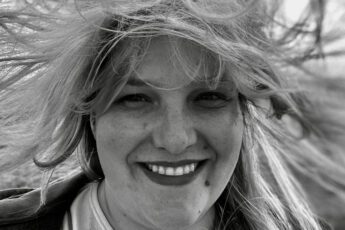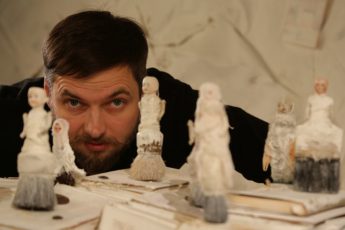The Architecture of (Un)Freedom
Leida Laius and Arvo Iho’s Smile at Last (Naerata ometi, 1985)
Vol. 152 (February 2025) by Margarita Kirilkina
Smile at Last by Estonian directors Leida Laius and Arvo Iho tells the story of a group of teenagers from an orphanage: their interactions with each other, with their caretakers, and with the remaining members of their families. The film unfolds across three distinct locations: a typical Soviet apartment in a high-rise block – the symbolic family cell – a state-run boarding school for adolescents – an epitome of institutionalization – and an abandoned house hidden in the bushes – a space of childlike fantasy.
At the beginning of the film, the protagonist Mari (Monika Järv), a teenage girl, is found in her father’s apartment, a cluttered space strewn with empty alcohol bottles, where she is hiding away after fleeing from the orphanage. Her father, drunk, is completely shocked by the sudden appearance of his daughter, who he had written out of his life. His girlfriend, also present, wasn’t even aware of Mari’s existence. Everything is filthy, and no matter how much Mari tries to clean, the trash and bottles remain. The space is so cramped it barely fits within the camera frame; the camera itself is constantly bumping into corners and walls. The space feels suffocating – claustrophobic, stale, hopeless, a place that has outlived itself. This space symbolically represents the collapse of the family as an institution. Instead of the ideal Soviet household, the screen presents the death of familial bonds, the father’s degradation symbolizing the decay of authority and the regime, which, at the time of filming, is entering its final phase: perestroika – the reform program instituted by Gorbachev in the 1980s that would mark the transition from the Soviet era to the modern world.
Mari’s defiant departure from this space becomes a manifesto of the youth rejecting the powers that be. She spends the night at a train station, which here plays the role of a transitional space between a deteriorated past and a still-undefined future. The station is filled with other teenagers just like Mari who also appear to be waiting for something, yet lacking a clear sense of direction or a destination.
Mari locks eyes with Robi (Hendrik Toompere Jr.), a boy who’s part of a group of local delinquents – standard antiheroes of Soviet cinema. Their glances are exchanged through a series of frontal close-ups of their faces, one after the other. This frontal gaze directly confronts the viewer with the character. Mari’s face appears in front of the viewer, neither acting nor embellished, her fixed stare piercing the viewer, forming a direct connection and revealing her individuality – isolated from the collective body of the Socialist regime. Robi responds in kind, with a mirrored close-up. Two lonely figures meet, longing for something new. It seems that love is about to blossom. But Robi suddenly makes a mocking face at Mari and the viewer, shattering expectations. In the next scene, he and his gang surround Mari in a small square, forming a dense, tactile circle, setting the stage for a scene of violence – but that doesn’t happen either. A group of girls attacks the boys and rescues Mari in a physical fight. Just as Mari overcomes the patriarchal rule of her father and the regime, so here the girls physically overpower the boys. Seeming passivity turns into a source of strength and power.
The next setting, the orphanage, is an organized space with various rooms: a canteen, a room with a film projector, a piano room, a girls’ dorm – collective spaces through which both the characters and the camera move, reflecting the socially organized world of Soviet daily life. The building is typical of Soviet urban planning, and the behavior of the characters within it reflects the discipline and regimentation associated with that architecture. The orphanage, as an official institution, provides basic needs but promises no love. It’s a space of collectivity, where frontal close-ups are almost impossible – there’s no room for individuality. This is reinforced by the fact that many of the girls wear identical blue tracksuits typical of the time. Collectivity is also emphasized through shared tasks, like peeling potatoes, a mundane chore that contrasts with the idealized image of collective labor in Soviet cinema, where it tended to be celebrated as a source of joy and unity.
Robi also lives here. But there’s another character – his cousin Tauri (Tauri Tallermaa) – a moral, upright, “perfect” Soviet cinema hero, the polar opposite of rebellious Robi. The boys constantly clash, symbolizing the conflict between discipline and defiance. Robi belongs to a different space – a secret one hidden in the bushes near the school. It is a fantastical place, shaped by the teenagers’ desire to escape the grey walls of the institution, dull and outdated as it is.
The teens call this place “the villa.” It is only here that they unleash their imagination, express themselves, paint on the walls, dance, and fall in love. A chair is nailed to the ceiling upside down – a sign of an inverted world, a reality that cannot yet exist outside of youthful imagination. The space has no windows, but paradoxically it still offers a sense of freedom. There are no attributes of Soviet everyday life here. The place is half-ruined, yet it feels like somewhere new could be built – dreamy and different. Even the camera behaves more freely, capturing characters from unusual angles – clearly handheld, unrestricted by rigid movement. The characters sometimes look directly into the lens, creating a sense of documentary realism that is more truthful than what we saw before.
Despite the surreal nature of this setting, this is where “real” life happens – filled with passions, tears, and laughter. The key dramatic conflict between Tauri (the moral hero) and Robi (the antihero) unfolds here, both of them being in love with Mari. But Mari defies the expected logic of Soviet morality and chooses the “bad guy” – Robi, the only one who resists the crumbling world around them. As the story unfolds, Robi transforms into a more positive figure – the only one capable of empathy. Between other characters, communication has become nearly impossible, always ending in fights or arguments.
Thus, a space that seems ruined offers an alternative to systems that seemed solid and enduring – the family and the state institution. On the surface, these systems function, but symbolically they are already degraded and obsolete. The house without windows or doors becomes a place where a new story can begin – where yesterday’s antiheroes become heroes, where love and art are possible, where there is freedom to start with a blank page and build a new world shaped by youthful desires. And it’s precisely these feelings that dominated the era of perestroika.




Leave a Comment